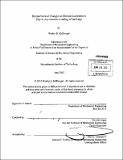Biomechanical changes to human locomotion due to asymmetric loading of the legs
Author(s)
McDougal, Wesley D
DownloadFull printable version (5.814Mb)
Other Contributors
Massachusetts Institute of Technology. Dept. of Mechanical Engineering.
Advisor
Neville Hogan.
Terms of use
Metadata
Show full item recordAbstract
The biomechanics of lower limb locomotion is a yet unknown mixture of neurological control and physical parameters. The current study explored attaching a rehabilitative anklebot to subjects walking on a treadmill and observed duration, kinematic, and electromyography data to determine the biomechanical response to the asymmetric loading. The present report identified various gait cycle parameters that changed as a response to the asymmetric loading. Notably, significant differences in the stride time of the legs occurred under loading, while contralateral stride times also adjusted to remain equal to those of the loaded legs. Symmetry index analysis led to the conclusion that, while the asymmetric loading of the lower limbs had some effects on temporal gait parameters, the body adjusted to minimize any temporal asymmetry. However, goniometer data demonstrated kinematic changes in response to loading as knee flexion peaked earlier in the gait cycle.
Description
Thesis (S.B.)--Massachusetts Institute of Technology, Dept. of Mechanical Engineering, 2012. Cataloged from PDF version of thesis. Includes bibliographical references (p. 51).
Date issued
2012Department
Massachusetts Institute of Technology. Department of Mechanical EngineeringPublisher
Massachusetts Institute of Technology
Keywords
Mechanical Engineering.